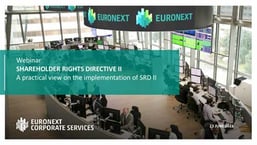A year after Belgium adopted the law implementing the Shareholder Rights Directive II (SRD II), we gathered a panel of experts to discuss its progress. Benoît van den Hove, Head of Listing at Euronext Brussels, was joined by Deborah Janssens, a partner at Freshfields, Mathieu Mitevoy, Director of Product Management at Euroclear Belgium, and Euronext Corporate Services’ Head of Advisory and IR Solutions Nicolas Meunier. The audience included Investor Relations Officers (IRO), Chief Financial Officers (CFOs) and other interested parties, who took part in an open and interactive discussion.
|
Table of content |
WebinarA practical view on the implementation of SRD II
|
Background to SRD II
Deborah Janssens of Freshfields presented the keynote speech, beginning with a recap of the intentions behind SRD II, namely to “improve long-term engagement of shareholders and transparency in listed companies”. Deborah noted that, not only does SRD II offer tools to shareholders, but it also provides benefits to issuers.
Improved shareholder engagement opportunities
As a result of SRD II, issuers are entitled to identify investors and collect key data to better inform their engagement processes. It is this opportunity to better relate with shareholders that informed the main thrust of the webinar. Deborah Janssens explained that, in Belgium, the right to identify shareholders is open to issuers with a registered seat and whose shares are traded on an EEA regulated market, such as Euronext Brussels, but not on multilateral trading facilities (MTF).
Issuers can request information on the identity of legal or natural persons from intermediaries inside and outside of the EU such as investment firms, credit institutions and central securities depositories (CSDs). It should be noted that the right to identify shareholders can only be used for the purposes of engagement and not for commercial activity or marketing.
Although some nations only allow issuers to identify investors who hold at least one per cent of the overall holding, as is allowable under SRD II, there is no limit in Belgium. This provides the opportunity to see a complete overview of your shareholder base, but that can also lead to an overload of data. Setting a minimum holding amount when you request to identify your shareholding means that you can reduce the amount of data you receive and make it more manageable.
What can you find out about your shareholders?
Companies can find out the identity of shareholders, as well as the number of shares held, their legal identifiers, address, email address and the name and identifier of any third party authorised to make investment decisions on their shares.
The law refers to ‘shareholders’, as it is defined under Belgian law, meaning that it does not include bondholders or beneficial owners. However, in the case of nominees, there is an argument that they are intermediaries and, as such, should be required to disclose details on the identities of the persons for whom they are holding shares. Mathieu Mitevoy of Euroclear Belgium believes this will allow companies to receive 100% of the data on beneficial ownership very soon.
Issuers must pay fees to identify shareholders and can submit their request at any point of the process, but must do so in machine-readable ISO formats, stating whether they want to know about the shareholding as it stands or as it stood on a particular date. Of course, being able to identify shareholders does not necessarily lead to being able to engage with them. Shareholders have the right to ignore any engagement requests made by issuers.
Discovering future voting behaviours
As part of SRD II, asset managers and institutional investors have to disclose certain information that can help issuers understand potential future voting behaviours. This includes:
- Investor engagement policies and how these policies integrate into the asset manager’s or institutional investor’s investment strategy
- How they exercise their voting rights
- Disclosing the arrangement between institutional investors and asset managers, and how they incentivise them
- Asset managers disclosing to the institutional investor how they act in their interest
How does the right to identify shareholders work in practice?
Mathieu Mitevoy of Euroclear Belgium discussed the results from Euroclear InvestorInsight, a tool that provides actionable insights to issuers and an easy-to-use method of compliance for intermediaries.
Mathieu revealed the tool had helped identify hundreds of thousands of investors across more than 130 countries, through more than 700 intermediaries who are currently using it. However, he admitted there were a number of additional elements required to truly leverage the opportunities from SRD II, including:
- Improved accuracy
- Increased simplicity in the system for ease of requesting and receiving information
- Safe collection and keeping of data with relation to GDPR and avoiding leaks
He also explained the complexity of ensuring full coverage when requests are made within a threshold, as well as for those requests with historic record dates. Mathieu described the need for standardisation in the message to increase the ability to automate the process. Currently, he explained, colleagues are often manually chasing intermediaries and some of those intermediaries are still not compliant with the directive.
How to make the most of the data
With the data you receive, you can:
- Analyse which types of investors make up your base
- Discover the impact of events such as roadshows and communications on your shareholding
- Finetune your messaging
- Ensure compliance with third-party country regulations
Nicolas Meunier of Euronext Corporate Services delved deeper into how to analyse the data to benefit issuers. He talked about working out points of contact, analysing the age and risk profile of the shareholding, understanding motivation and comparing previous investor interactions with the new data to check for consistency.
Describing this kind of shareholder analysis as a “must-have”, Nicolas explained that the return on investment was very much worth the efforts of continually monitoring shareholders. He extolled the virtues of Shareholder Analysis, a service that enables issuers to make use of the raw data they receive about shareholders and provides high-level reports that they can put into action in their investor relations strategy. As a result of the shareholder analysis, issuers can also anticipate events such as activist behaviour, as well as ESG-related pressures.
A poll taken during the presentation showed that 40% of the audience intend to increase the frequency of shareholder analysis reports thanks to the increased transparency of SRD II. This shows significant support for Deborah Janssens’ findings that SRD II is not only useful for investors, but issuers can and should look to benefit from its implementation.
Webinar: A practical view on the implementation of SRD II
|
Related articles
-
Which ESG Metrics Should You Track? A Comprehensive Guide
Read the article -
New IESBA Standards – The Importance of Ethical Standards in Sustainability
Read the article -
The Benefits of Webcasting Your Capital Markets Day
Read the article
Share this post



